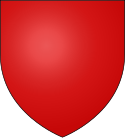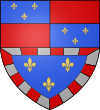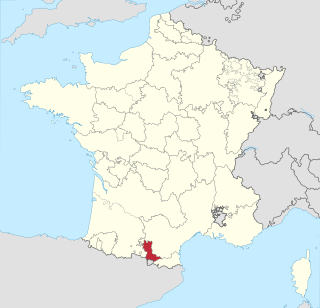

The House of Albret, which derives its name from the lordship (seigneurie) of Albret (Labrit), situated in the Landes, was one of the most powerful feudal families of France and Navarre during the Middle Ages.


The House of Albret, which derives its name from the lordship (seigneurie) of Albret (Labrit), situated in the Landes, was one of the most powerful feudal families of France and Navarre during the Middle Ages.
The work of Anthony M. H. J. Stokvis establishes the genealogy of the Albrets to start with the 800s AD Basque nobleman Jimeno of Pamplona, patriarch of the Spanish Jiménez dynasty. Members of the House of Albret distinguished themselves during the major local wars of that era. During the 14th century they espoused the English cause for some time, afterwards transferring their support to the side of France. [1]
Arnaud Amanieu I, Lord of Albret, helped to take Guienne from the English. His son Charles became constable of France, and was killed at the Battle of Agincourt in 1415. At that time the House of Albret had attained considerable territorial importance, due in great part to the liberal grants which it had obtained from successive kings of France.
The House of Albret then continued its ascension, favored by both Charles VI and Charles VII. It reached its apogee in the fifteenth and sixteenth centuries. They familiarized themselves with the court of France through their alliances. In 1470, they inherited the County of Périgord and the Viscounty of Limoges. Their new strength then allowed them to claim the inheritance of the Duchy of Brittany. [2]
Alain the Great, Lord of Albret (died 1522), wished to marry Anne of Brittany, and to that end fought against Charles VIII; but his hopes being ended by the betrothal of Anne to Maximilian of Austria, he surrendered Nantes to the French in 1486. [1]
They took possession of the county of Foix, when Jean I of Albret, son of Alain, became King of Navarre by his marriage with Catherine of Foix, Queen of Navarre in 1484. Their son Henry II, King of Navarre, was created Duke of Albret and a peer of France in 1550. By his wife Marguerite d'Angoulême, sister of Francis I, Henry II had a daughter, Jeanne d'Albret, Queen of Navarre, who married Anthony de Bourbon, Duke of Vendôme, and became the mother of Henry IV, King of France. [3] [4] [5]
These new possessions (Bearne, Foix, Bigorra, Tartas, Castres, Dreux, etc.) gave them a real political role in the Renaissance century. However, the Albrets did not stay long at the top of the society of orders. Navarre was invaded by Spain in 1512, and the house of Albret kept only the small part on the French side of the Pyrenees (Lower-Navarre), and Joan of Albret is the last of her name to sit on the throne, because the Dukedom of Albret, was united to the crown of France by the accession of the crown prince. [6]
The title of Duke of Albret was later granted to the family of La Tour d'Auvergne (see duc de Bouillon) in 1651, in exchange for Sedan and Raucourt. [7]
A cadet of this house was Jean d'Albret-Orval , seigneur of Orval, count of Dreux and of Rethel, governor of Champagne (died 1524), who was employed by Francis I in many diplomatic negotiations, more particularly in his intrigues to get himself elected emperor in 1519. [7]
Notable descendants include the Kings of Navarre (basque region), French-Mexican politicians, Gerardo Ruiz de Esparza and Luis Ruben de Valadéz (née Valadez-Hernandez II) from the marriage of Carlos Beaumont de Navarre, Count of Beaumont and Ana de Curton d'Albret, Dame of Curton and Guiche. [8] [9] [10]


| Figure | blasonnement |
 | lords d'Albret De gueules plain. [20] |
 | counts d'Albret , 14th century écartelé en 1 et 4 d'azur aux trois fleurs de lys d'or et en 2 et 3 de gueules. [20] |
 | Kings of Navarre parti de deux et coupé d'un : 1, de gueules aux chaînes d'or posées en orle, en croix et en sautoir, chargées en cœur d'une émeraude au naturel; en 2, contre-écartelé en 1 et 4 d'azur aux trois fleurs de lys d'or et en 2 et 3 de gueules; en 3, d'or aux quatre pals de gueules; en 4, contre-écartelé en 1 et 4 d'or aux trois pals de gueules, en 2 et 3 d'or aux deux vaches de gueules, accornées, colletées et clarinées d'azur, passant l'une sur l'autre; en 5, d'azur semé de fleurs de lys d'or à la bande componée d'argent et de gueules; et en 6, contre-écartelé en sautoir d'or aux quatre pals de gueules et de gueules au château d'or ouvert et ajouré d'azur et d'argent au lion de gueules armé, lampassé et couronné d'or; sur-le-tout d'or aux deux lions léopardés de gueules, armés et lampassés d'azur, passant l'un sur l'autre. [20] |
  | lords of Orval de gueules à la bordure engrélée d'argent et au bâton de sable péri en barre. [20] écartelé, au premier et au quatrième d'azur à trois fleurs de lys d'or, au deuxième et au troisième de gueules à la bordure engrêlée d'argent. [21] |
 | counts of Rethel coupé en 1 écartelé en 1 et 4 d'azur aux trois fleurs de lys d'or et en 2 et 3 de gueules et en 2 d'azur semé de fleurs de lys d'or à la bordure componée d'argent et de gueules. [22] |
{{cite journal}}: Cite journal requires |journal= (help)
Lower Navarre is a traditional region of the present-day French département of Pyrénées-Atlantiques. It corresponds to the northernmost region of the Kingdom of Navarre during the Middle Ages. After the Spanish conquest of Iberian Navarre (1512–24), this merindad was restored to the rule of the native king, Henry II. Its capitals were Saint-Jean-Pied-de-Port and Saint-Palais. In the extreme north there was the little sovereign Principality of Bidache, with an area of 1,284 km2 (496 sq mi) and a decreasing population of 44,450, 25,356.

The County of Foix was a medieval fief in southern France, and later a province of France, whose territory corresponded roughly the eastern part of the modern département of Ariège.

John III was King of Navarre from 1484 until his death in 1516 as the husband and co-ruler of Queen Catherine.

Charles I d'Albret was the Lord of Albret and the Constable of France from 1402 until 1411, and again from 1413 until 1415. He was also the co-commander of the French army at the Battle of Agincourt where he was killed by the English forces led by King Henry V.

Gaston IV was the sovereign Viscount of Béarn and the Count of Foix and Bigorre in France from 1436 to 1472. He also held the viscounties of Marsan, Castelbon, Nébouzan, Villemeur and Lautrec and was, by virtue of the county of Foix, co-prince of Andorra. From 1447 he was also Viscount of Narbonne. Through his marriage to Eleanor, heiress of the Kingdom of Navarre, he also held the title of Prince of Navarre.

The Counts of Dreux were a noble family of France, who took their title from the chief stronghold of their domain, the château of Dreux, which lies near the boundary between Normandy and the Île-de-France. They are notable for inheriting the Duchy of Brittany through Pierre de Dreux's marriage to Alix de Thouars in the early 13th century.

The Roman Catholic Diocese of Lescar, in south-western France, was founded in the fifth century, and continued until 1790. It was originally part of the Province of Novempopulania, and Lescar held the seventh place among the cities. Its see was the Cathedral of the Assumption in Lescar, begun in 1120; the crypt of the cathedral was also the mausoleum of the family of Albret in the 16th century.

Charles II d'Albret (1407–1471) was a French magnate, administrator, and soldier.

The Château de Nérac is a castle in the Lot-et-Garonne département in southwest France. An edifice of the French Renaissance style, it was finished during the reign of Jeanne d'Albret, Queen of Navarre, daughter of Marguerite d'Angoulème who was also Marguerite de Navarre by her marriage to Henry II of Navarre.

Alain I of Albret (1440–1522), called "The Great", was a powerful French aristocrat. He was 16th Lord of Albret, Viscount of Tartas, the 2nd Count of Graves and the Count of Castres. He was the son of Catherine de Rohan and Jean I of Albret. He was the grandson and heir of Charles II of Albret and became head of the House of Albret in 1471.

Anne of Armagnac, Dame d'Albret, Countess of Dreux was a French noblewoman and a member of the powerful Gascon Armagnac family which played a prominent role in French politics during the Hundred Years War and were the principal adversaries of the Burgundians throughout the Armagnac-Burgundian Civil War. Anne was the wife of Charles II d'Albret.

Charlotte of Albret, Dame de Châlus, was a wealthy French noblewoman of the Albret family. She was the sister of King John III of Navarre and the wife of the widely notorious Cesare Borgia, whom she married in 1499. She was the mother of his only legitimate child, Louise Borgia, to whom she acted as regent of the Duchy of Valentinois from 1507 to 1514, following the death of Cesare.

Isabella of Foix also known as Isabella of Foix-Castelbon was sovereign Countess of Foix and Viscountess of Béarn from 1399 until 1428. She was Countess of Foix in her own right, but shared power with her husband and later with her son. She succeeded as countess along with her husband upon the death of her childless brother Matthew.
John I, Count of Foix also known as Jean de Foix-Grailly was Count of Foix from 1428 until his death in 1436. He succeeded his mother Isabella, Countess of Foix. His father was Archambaud de Grailly.
Amanieu VI was a French nobleman, the Lord of Albret. The lordship (seigneurie) of Albret, in the Landes, gave its name to one of the most powerful feudal families of France in the Middle Ages. One of Amanieu’s descendants became king of Navarre; a later descendant was Henry IV, king of France.
Duke of Albret was a title in the French nobility.
Jean de Foix was the Captal de Buch, first Earl of Kendal, Vicomte de Castillon, Meilles and Comte de Benauges.
Frances de Châtillon was Countess of Périgord, Viscountess of Limoges, and Dame of Avesnes and Châlus.
Marie de Sully or Seuly was the Sovereign (Princess) of Boisbelle. She was the daughter of Louis I de Sully and his wife, Isabelle de Craon.
Attribution: